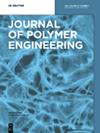Effect of epoxidized soybean oil on melting behavior of poly(l-lactic acid) and poly(d-lactic acid) blends after isothermal crystallization
IF 1.7
4区 工程技术
Q4 POLYMER SCIENCE
引用次数: 0
Abstract
The effect of epoxidized soybean oil (ESO) on homocrystallization (HC) and stereocomplex (SC) formation behavior of poly(环氧化大豆油对聚(l-乳酸)和聚(d-乳酸)混合物等温结晶后熔融行为的影响
利用差示扫描量热法(DSC)研究了环氧化大豆油(ESO)对聚(l-内酯)(PLLA)和聚(d-内酯)(PDLA)弯管的同质结晶(HC)和立体络合物(SC)形成行为的影响。对不同ESO含量(0、5、8和10 wt%)和不同温度(90 °C、120 °C和150 °C)的ESO/PLLA/PDLA混合物进行了等温结晶,持续时间(12.5、25和125分钟)各不相同。结果发现,ESO 能有效抑制 HC 结晶,促进 SC 结晶。对于不含 ESO 的样品(ESO-0),等温结晶温度和持续时间对其熔化行为影响不大,而含有 5 wt% ESO 的样品(ESO-5),随着持续时间的增加,HC 结晶减少,而 SC 结晶继续增加。此外,在ESO含量不变的情况下,在较高的结晶温度下,SC晶体的熔化温度没有显著变化,这表明ESO不会降解PLLA/PDLA共混物。这些发现表明,ESO 改变了结晶动力学,抑制了 HC 的形成,促进了 SC 的形成,从而有利于特定材料的性能和应用。
本文章由计算机程序翻译,如有差异,请以英文原文为准。
求助全文
约1分钟内获得全文
求助全文
来源期刊

Journal of Polymer Engineering
工程技术-高分子科学
CiteScore
3.20
自引率
5.00%
发文量
95
审稿时长
2.5 months
期刊介绍:
Journal of Polymer Engineering publishes reviews, original basic and applied research contributions as well as recent technological developments in polymer engineering. Polymer engineering is a strongly interdisciplinary field and papers published by the journal may span areas such as polymer physics, polymer processing and engineering of polymer-based materials and their applications. The editors and the publisher are committed to high quality standards and rapid handling of the peer review and publication processes.
 求助内容:
求助内容: 应助结果提醒方式:
应助结果提醒方式:


